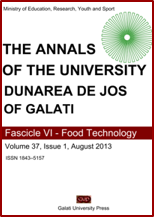Bioethanol production from residual lignocellulosic materials: A review – Part 1
Abstract
Lignocellulosic materials (LCM) are produced in large quantities and without clear application and their use as raw material for bioethanol production shows economic and ecologic benefits. LCM are composed mainly of three polymers: cellulose made up of glucose units, hemicellulose made up of several sugars (as xylose or arabinose), and lignin made up of phenylpropane units, interconnected in a strong structure. Pretreatment is an important step for bioethanol production from LCM, causing the solubilisation of hemicellulosic fraction (leading to the recovery of hemicellulose-derived saccharides) in order to obtain a solid phase enriched in cellulose and more susceptible to enzymatic attack. This study provides a comparative data regarding the chemical composition of various LCM used for bioethanol production, as well as different pretreatment technologies for improving the enzymatic hydrolysis of LCM.


